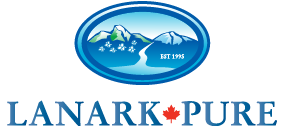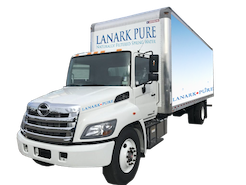
Virginality
This deals with the concentration of nitrate in the water, which may come from the natural breakdown of organic material (decaying vegetation) in low concentrations and is often an indication of contamination from fertilizers, sewage, or animal waste if the concentration is higher. Drinking water quality (DWQ) guidelines use 10 mg/L as an upper limit for nitrate due to its impact on babies and young infants that drink water with elevated nitrate concentrations developing ‘blue baby syndrome’, which is caused by nitrate breakdown affecting iron in the hemoglobin by blocking the iron from carrying oxygen to individual cells. This does not appear to be an issue for older children or adults. All of the waters listed are less than 1.0 mg/L and well within the DWQ guidelines. For Lanark (Seven 0.19 mg/L), the nitrogen source is from the natural decay of vegetation (leaf litter, etc.) on the ground surface being incorporated into the precipitation during infiltration to the subsurface.
Minerality
This category equates the “subtle taste and terroir” of the water to their total dissolved solids (TDS) content. This is basically true, with high iron and manganese concentrations leading to the greatest number of complaints among consumers. High sodium concentrations can give water a slippery feel while excessive calcium, magnesium and bicarbonate/carbonate (hardness and alkalinity) can at times leave a chalky taste. Organic constituents dissolved in the water can lead to odour and colour issues which often are related to taste.
DWQ guidelines recommend less than 500 mg/L of TDS, and mineral waters have TDS values greater than 250 mg/L. Some bottled mineral waters from eastern Europe have concentrations exceeding 1000 mg/L TDS. The presence of various chemical elements and compounds are important for body functions (see WHO report on Nutrients in Drinking Water, 2005), while pure (distilled or reverse osmosis (RO)) water can lead to deficiencies in essential elements and even leaching of essential elements from the body. The Lanark water contains essential elements, such as calcium, magnesium and bicarbonate,
while maintaining low enough TDS concentrations to provide a clean and fresh taste.
Orientation/pH
pH, the measure of the hydrogen ion activity, is an important parameter for water. DWQ guidelines recommend that the pH should be between 6.5 and 8.5. Although a pH of 7.0 is considered neutral, a higher (alkaline or basic) level is recommended. Water with a pH below 7.0 is acidic and is considered corrosive for metal pipes and fixtures. The VOSS water has a pH of 5.5, below the recommended range and is probably due to low alkalinity (bicarbonate) which is also reflected in the low TDS.
Sweetness is a marketing term but is correct in that the taste is neither bitter nor sour. In ancient times, the Greeks often referred to ‘fresh’ water as ‘sweet’ water in contrast to the bitter taste of highly mineralized water like sea water. It should be noted that in the comparison information (under the heading alkaline) it states that water with a pH of 7.1 to 7.5 “may be perceived as sweet”. Lanark water at a pH of 7.7 is slightly above this definition but is labelled as “with a hint of sweetness”, which is either stretching the range or demonstrating the arbitrary limits of “sweetness”. Nevertheless, the optimum pH range is 7.0 to 8.0.
Hardness
Hardness is the combined concentration of calcium and magnesium ions in the water and for DWQ purposes it is probably better to look at the individual concentrations of the two elements. Municipal water supplies often adjust the hardness of their water by using water softeners (Sodium cation exchange) to values between 80 and 100 mg/L. Individual well owners who depend on their well water for household use also often run the water through a water softening system to reduce the hardness. When high concentrations of calcium and magnesium are present in water, it depresses the ability of soaps to create suds, and can cause precipitation of scale/lime when the water is heated. These are technical issues that are unrelated to drinking/consumption of the water; DWQ guidelines for both calcium and magnesium are <250 mg/L for each. In fact, calcium is very beneficial for our bones and teeth, blood coagulation, nervous system function, and enzyme and hormonal responses. A deficiency (low concentration) of calcium in drinking water increases the risk of coronary disease and bone fractures (WHO 2005). Likewise, magnesium supports the immune system and is very important for many metabolic functions and muscular and nerve activity. Magnesium is responsible for the relaxation of muscles, while calcium is responsible for the contraction of muscles. Magnesium deficiencies in drinking water have been associated with increased risk of cardiovascular disease. One should not drink soft water, especially if it has been artificially softened by sodium cation exchange, as will be discussed in the next section.
Sodium
Sodium is the most important element for balancing electrolytes and water in the body and is the reason that athletes often consume electrolyte-rich beverages during periods of strenuous exercise. The DWQ guidelines do not specify a maximum limit for sodium, other than an aesthetic value of 200 mg/L. Since many people receive excess sodium through their food supply, some groups recommend keeping sodium concentrations in water below 20 mg/L, especially for people with coronary or hypertension conditions. On the basis of this excess dietary salt intake and given the high rates of health related issues, low concentrations of sodium in a bottled water is desirable. Most ‘soft’ waters are created by running ‘hard’ water through a sodium cation exchange system. This reduces the hardness (reduces the calcium and magnesium concentrations) but raises the sodium concentrations in the ‘softened’ water to very high levels. Given the health concerns regarding excess sodium in diets, this water should never be consumed as a drinking water, whether bottled or from the tap.
Overall, looking at these five parameters, the ideal water would contain:
- Very low levels of nitrate
- An alkaline pH in the range of 7.0 to 8.0
- A moderate TDS content
- Primarily calcium and magnesium cations
- Relatively low sodium content
The spring water from Lanark meets all of these requirements and is low in other dissolved substances, such as iron, sulfate, and organics that could otherwise impact the taste, colour and odour qualities of the water. Click Here For Our Certificate Of Analysis
Comparing some of the premium waters on the market.
Most have acceptably low nitrate values. Lanark has by far the lowest among all waters examined.
VOSS has low pH, very low TDS (almost like RO), low calcium and magnesium, but somewhat elevated sodium.
Fiji is good in terms of pH and TDS, but is low in calcium and magnesium and elevated in sodium. Nitrate level is also higher than Lanark.
Evian has good pH, but elevated TDS and sodium contents, and is very high in hardness. This high TDS and hardness may affect taste.
Lanark best reflects all of the attributes listed above that one would want to see in a water.
Reference:
World Health Organization, 2005. Nutrients in Drinking Water. Water, Sanitation and Health Protection and the Human Environment, WHO, Geneva, Switzerland. 196 pages. www.who.int/water_sanitation_health/dwq/nutrientsindw.pdf
Frederick A. Michel, PhD, P. Geo.
Local Retailers
Barnabe’s Independent (Perth)
Brownlee’s Metro (Perth)
Patrice’s Independent (Almonte)
Dandelion Foods (Almonte)
Metro (Renfrew)
Kudrinkos Grocery (Westport)
Verona Foodland (Verona)
Fargos Grocery (Wolfe Island)
Select Circle K
Glenburnie Grocery (Glenburnie)
King’s Independent (Richmond)
The Garden Market (Smiths Falls)
Andress’s Independent Grocer (Smiths Falls)
Giant Tiger (Smiths Falls)
Mike Dean’s Local Grocer (Sharbot Lake)
Pick Up From Our Plant*
*Monday - Thursday from 8:00 a.m. - 3:00 p.m.

